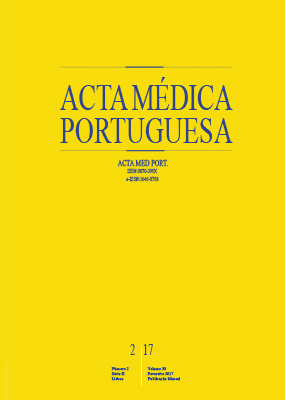Secular Trends in Anthropometrics and Physical Fitness of Young Portuguese School-Aged Children
DOI:
https://doi.org/10.20344/amp.7712Keywords:
Anthropometry, Body Mass Index, Child, Growth and Development, Physical Fitness, PortugalAbstract
Introduction: The purpose of this study was to analyze secular trends in anthropometrics and physical fitness of Portuguese children.
Material and Methods: A group of 1819 students (881 boys and 938 girls) between 10 and 11 years old was assessed in their 5th and 6th scholar grade throughout a 20 years’ time-frame. ANCOVA models were used to analyze variations in anthropometrics (height, weight and body mass index) and physical fitness (sit and reach, curl-up, horizontal jump and sprint time) across four quinquennials (1993 - 1998; 1998 - 2003; 2003 - 2008; 2008 - 2013).
Results: Secular trends showed the presence of heavier boys and girls with higher body mass index in the 5th and 6th grade throughout the last 20 years. There was also a presence of taller girls but just until the 3rd quinquennial. Both boys and girls were able to perform better on the core strength test and sprint time but become less flexible over the years. Mean jumping performance remained unchanged for both genders.
Discussion: The present study provides novel data on anthropometrics and physical fitness trends over the last two decades in young Portuguese children, consistent with the results reported in other developed countries.
Conclusion: Evidence for the start of a positive secular trend in body mass index and in some physical fitness components over the last two decades among the Portuguese youth.
Downloads
Downloads
Published
How to Cite
Issue
Section
License
All the articles published in the AMP are open access and comply with the requirements of funding agencies or academic institutions. The AMP is governed by the terms of the Creative Commons ‘Attribution – Non-Commercial Use - (CC-BY-NC)’ license, regarding the use by third parties.
It is the author’s responsibility to obtain approval for the reproduction of figures, tables, etc. from other publications.
Upon acceptance of an article for publication, the authors will be asked to complete the ICMJE “Copyright Liability and Copyright Sharing Statement “(http://www.actamedicaportuguesa.com/info/AMP-NormasPublicacao.pdf) and the “Declaration of Potential Conflicts of Interest” (http:// www.icmje.org/conflicts-of-interest). An e-mail will be sent to the corresponding author to acknowledge receipt of the manuscript.
After publication, the authors are authorised to make their articles available in repositories of their institutions of origin, as long as they always mention where they were published and according to the Creative Commons license.









